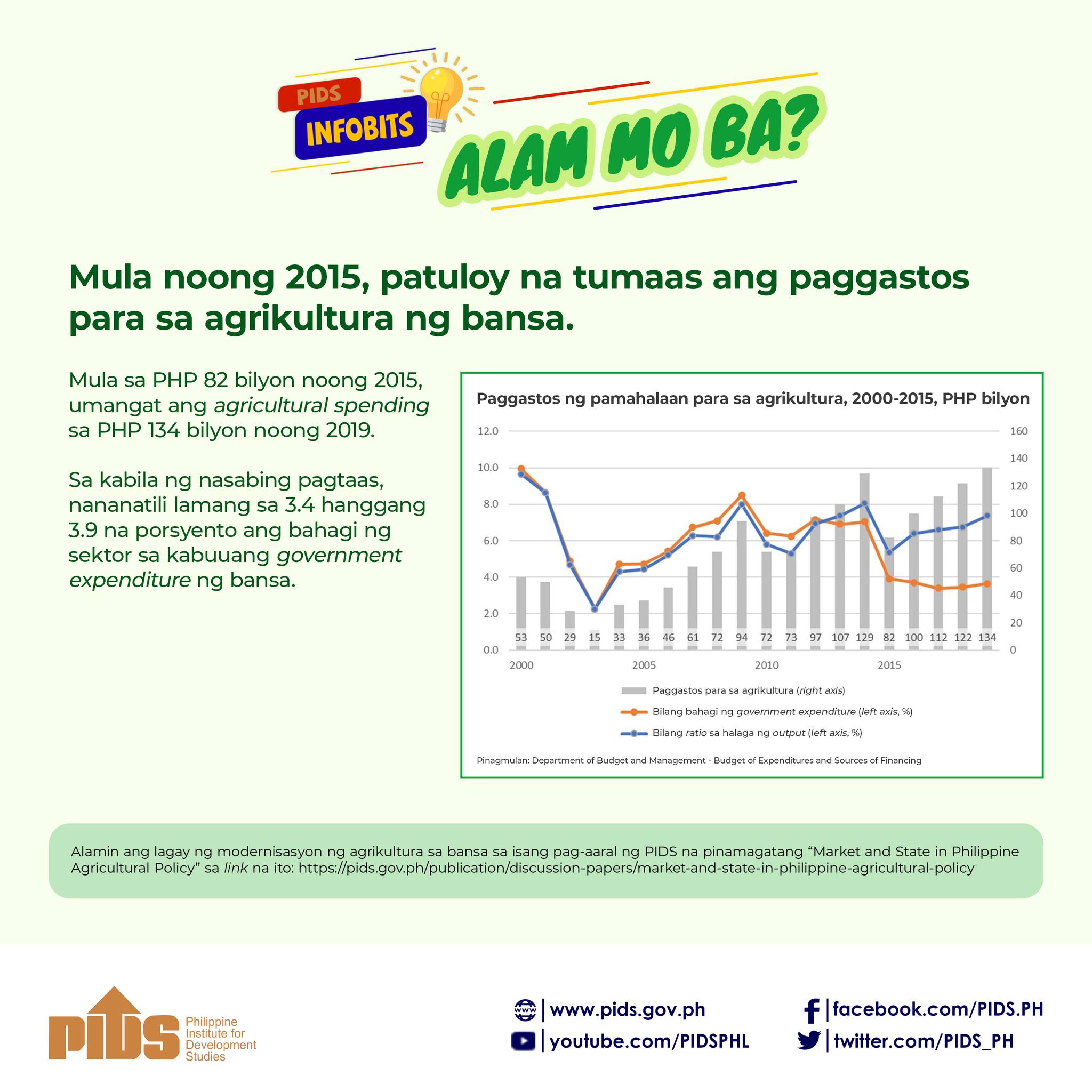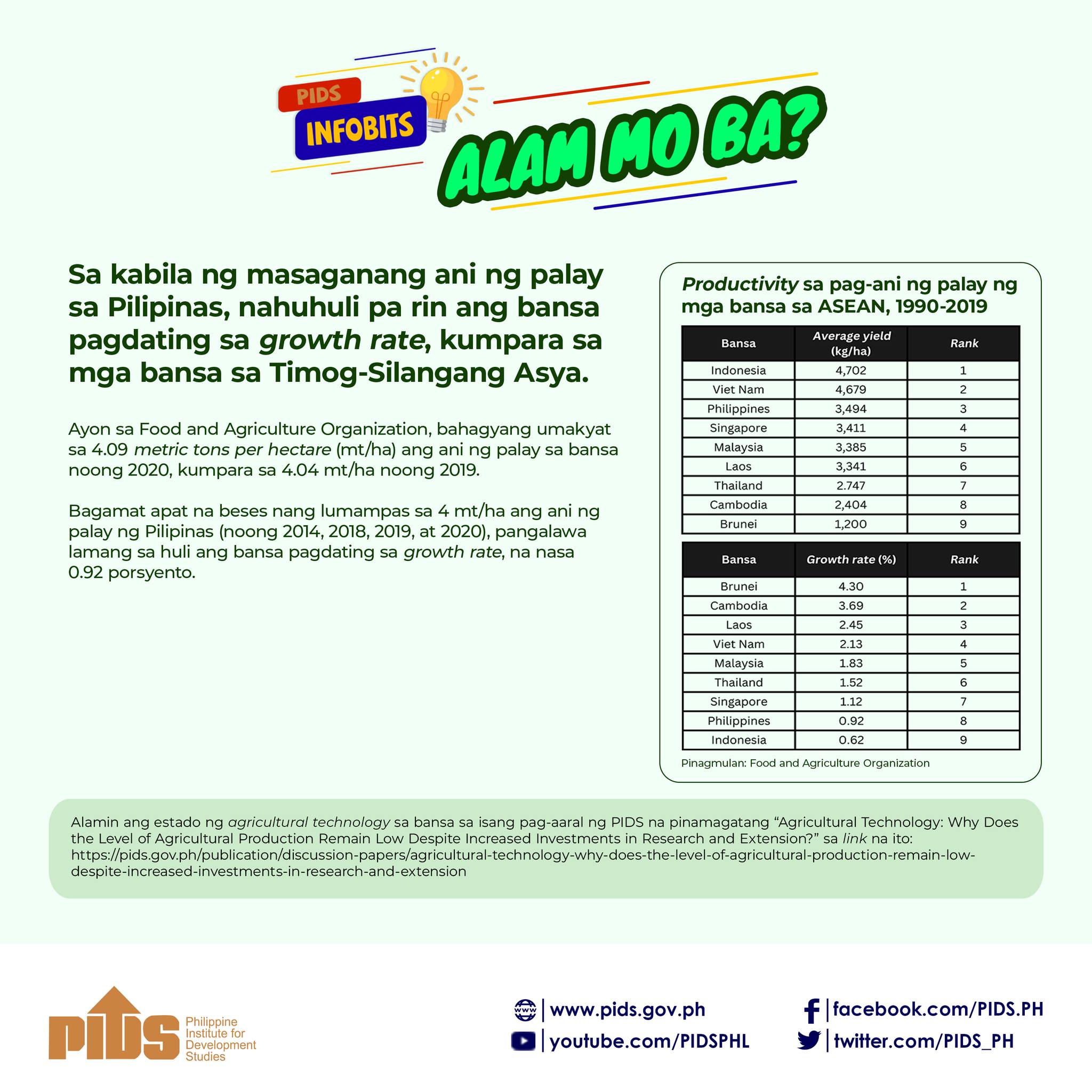The country’s external trade for agricultural commodities improved 13.6 percent to $4.554 billion in the fourth quarter of 2016, from $4.010 billion during the same period in 2015, according to the Philippine Statistics Authority (PSA).
As a result, the country’s agricultural trade deficit in the fourth quarter last year shrank 10 percent to $1.686 billion against the $1.873 billion deficit recorded in the same period in 2015.
The PSA attributed the improvement in our agricultural trade to higher agricultural commodities the Philippines exported during the October-to-December period.
Agricultural exports increased by 34.2 percent to $1.434 billion in the fourth quarter of 2016, from $1.068 billion in the same quarter of 2015. Moreover, share of agricultural exports to total exports went up 9.8 percent in the fourth quarter of 2016, from 7.4 percent in the fourth quarter of 2015,” the PSA added.
Among the country’s major trading partners for agricultural commodities, Japan posted a trade surplus of $102.97 million in the fourth quarter of 2016, 134.93 percent higher than the $43.83- million trade surplus during the same period in 2015, the PSA said.
Other major trading partners for agricultural commodities were Australia, with trade deficit of $109.91 million; the US, with trade deficit of $301.83 million; Asean and the European Union, each with $784.93-million and $15.13-million trade deficit, respectively,” the PSA said.
>The PSA noted that among the commodity groups, exports of food and live animals posted the highest value, reaching $893.40 million in the fourth quarter of 2016. The figure was 3.5 percent higher than the $862.84-million recorded earnings from the commodity group in the October-to-December period of 2015, the PSA said.
Total vegetables and fruits exported in the fourth quarter of 2016 reached 744,360 metric tons (MT), 72.52 percent higher than the 431,450 MT exported in the same period in 2015. The Philippines earned $469.62 million from the exported volume, which is 31.98 percent higher than the $355.82 million earned in 2015.
Coconut oil was the top imported agricultural product from the Philippines during the fourth quarter last year. The Philippines exported 257,240 MT of coconut oil, which is 26.89 percent higher than the 202,730 MT exported in the fourth quarter of 2015.
It recorded a high 75.5-percent growth, from $233.86 million in the fourth quarter of 2015 to $410.51 million in the same quarter of 2016,” the PSA said. Coconut-oil exports accounted for 28.6 percent of total agricultural exports.
Furthermore, the US was the major market, valued at $191.49 million, accounting for a 46.6-percent share to total coconut oil exports,” the PSA added. The US bought 115,090 MT of coconut-oil from the Philippines during the period.
Fresh bananas were the second most-bought agricultural produce of the Philippines, which accounted for 12 percent of total exports.
>In the fourth quarter last year, purchase of fresh bananas by the country’s trading partners expanded to 438,510 MT, from 172,600 MT in 2015. Export receipt from fresh bananas during the period was valued at $172.64 million, 113.47 percent higher than the $80.87 million recorded during the same period in 2015.
Japan remained as the top buyer of fresh Philippine bananas, importing some 123,950 MT, which is 28.27 percent of the total volume exported, valued at $62.57 million.Philippine Institute for Development Studies senior research fellow Roehlano M. Briones said the Philippine agricultural exports’ lackluster performance in recent years is expected to change this year on the back of favorable planting conditions. “It will recover [this year], because the decline in exports in the past two years is weather related. So, hopefully, it would recover this year,” Briones told the BusinessMirror.Briones said the Philippines should ramp up its local production of agricultural goods to meet the growing demands abroad, especially with the series of trade deals secured by the country with its trading partners. &ldquo
Basically, it’s all about the supply side, because the demand will always be there consistently,” Briones said.So, what I’ve also been hearing is that it’s not about the market, but the problem is coming up with the supply to make the orders across the board, especially for export-oriented products,” Briones added.
The Philippines has secured a lot of agriculture-related investment deals with trade partners from the series of state visits by President Duterte. These include the $1.250 billion worth of agriculture investments from Qatar, Saudi Arabia and Bahrain. The bulk of the investments would be used in funding various export-oriented agribusiness projects in Mindanao.
One project is the $250-million investment agreement between AMA Group Holding Corp. and Nader & Ebrahim Sons of Hassan Co. W.L.L. that would cover 10,000-hectare farmland expansion in Mindanao that is expected to result in an annual export of 560,000 MT of various fruits worth $280 million. “The assumption before was there was not enough demand, because we didn’t publicize the Philippines enough. Now, we have publicized the Philippines,” Briones said. <
But the Philippines is well known for not being able to deliver. So that’s the problem, not the fact that there’s not enough orders,” Briones added.
Briones also said the government should reduce red tape to entice Filipino exporters to ship out new value-added agricultural products.
There are a lot of bottlenecks, including regulations. I’ve been hearing complaints that it is getting longer and longer to get the approval for a new export product as a legitimate Philippine-made product,” he said.
So, the tendency is that rather than making new products, what they do is just continue selling whatever they have already registered several years ago. So, if the government made the procedures much easier, much faster, then the exporters would probably be able to respond faster [to demand],” he added.
The PIDS senior research fellow also said the government should start crafting a comprehensive plan to address land administration and management in the<
country to entice investors to invest in agriculture.
We have to really troubleshoot land administration and management, which is part of the 10-point socioeconomic agenda—and I haven’t seen any serious initiatives,” Briones said.
One of the Duterte administration’s 10-point socioeconomic agenda is ensuring security of land tenure to encourage investments and address bottlenecks in land management and titling agencies.&rdquo
Briones said if the Philippines seeks to increase its exports share in Asean, it should practice more value-adding of agricultural products.
f you’re going to intensify intra-Asean trade in agriculture, it has to be value-added processed products,” he said. Despite the increase in agricultural exports, the Philippines remained as a net importer of agricultural commodities in the fourth quarter of 2016.
As a result, the country’s agricultural trade deficit in the fourth quarter last year shrank 10 percent to $1.686 billion against the $1.873 billion deficit recorded in the same period in 2015.
The PSA attributed the improvement in our agricultural trade to higher agricultural commodities the Philippines exported during the October-to-December period.
Agricultural exports increased by 34.2 percent to $1.434 billion in the fourth quarter of 2016, from $1.068 billion in the same quarter of 2015. Moreover, share of agricultural exports to total exports went up 9.8 percent in the fourth quarter of 2016, from 7.4 percent in the fourth quarter of 2015,” the PSA added.
Among the country’s major trading partners for agricultural commodities, Japan posted a trade surplus of $102.97 million in the fourth quarter of 2016, 134.93 percent higher than the $43.83- million trade surplus during the same period in 2015, the PSA said.
Other major trading partners for agricultural commodities were Australia, with trade deficit of $109.91 million; the US, with trade deficit of $301.83 million; Asean and the European Union, each with $784.93-million and $15.13-million trade deficit, respectively,” the PSA said.
>The PSA noted that among the commodity groups, exports of food and live animals posted the highest value, reaching $893.40 million in the fourth quarter of 2016. The figure was 3.5 percent higher than the $862.84-million recorded earnings from the commodity group in the October-to-December period of 2015, the PSA said.
Total vegetables and fruits exported in the fourth quarter of 2016 reached 744,360 metric tons (MT), 72.52 percent higher than the 431,450 MT exported in the same period in 2015. The Philippines earned $469.62 million from the exported volume, which is 31.98 percent higher than the $355.82 million earned in 2015.
Coconut oil was the top imported agricultural product from the Philippines during the fourth quarter last year. The Philippines exported 257,240 MT of coconut oil, which is 26.89 percent higher than the 202,730 MT exported in the fourth quarter of 2015.
It recorded a high 75.5-percent growth, from $233.86 million in the fourth quarter of 2015 to $410.51 million in the same quarter of 2016,” the PSA said. Coconut-oil exports accounted for 28.6 percent of total agricultural exports.
Furthermore, the US was the major market, valued at $191.49 million, accounting for a 46.6-percent share to total coconut oil exports,” the PSA added. The US bought 115,090 MT of coconut-oil from the Philippines during the period.
Fresh bananas were the second most-bought agricultural produce of the Philippines, which accounted for 12 percent of total exports.
>In the fourth quarter last year, purchase of fresh bananas by the country’s trading partners expanded to 438,510 MT, from 172,600 MT in 2015. Export receipt from fresh bananas during the period was valued at $172.64 million, 113.47 percent higher than the $80.87 million recorded during the same period in 2015.
Japan remained as the top buyer of fresh Philippine bananas, importing some 123,950 MT, which is 28.27 percent of the total volume exported, valued at $62.57 million.Philippine Institute for Development Studies senior research fellow Roehlano M. Briones said the Philippine agricultural exports’ lackluster performance in recent years is expected to change this year on the back of favorable planting conditions. “It will recover [this year], because the decline in exports in the past two years is weather related. So, hopefully, it would recover this year,” Briones told the BusinessMirror.Briones said the Philippines should ramp up its local production of agricultural goods to meet the growing demands abroad, especially with the series of trade deals secured by the country with its trading partners. &ldquo
Basically, it’s all about the supply side, because the demand will always be there consistently,” Briones said.So, what I’ve also been hearing is that it’s not about the market, but the problem is coming up with the supply to make the orders across the board, especially for export-oriented products,” Briones added.
The Philippines has secured a lot of agriculture-related investment deals with trade partners from the series of state visits by President Duterte. These include the $1.250 billion worth of agriculture investments from Qatar, Saudi Arabia and Bahrain. The bulk of the investments would be used in funding various export-oriented agribusiness projects in Mindanao.
One project is the $250-million investment agreement between AMA Group Holding Corp. and Nader & Ebrahim Sons of Hassan Co. W.L.L. that would cover 10,000-hectare farmland expansion in Mindanao that is expected to result in an annual export of 560,000 MT of various fruits worth $280 million. “The assumption before was there was not enough demand, because we didn’t publicize the Philippines enough. Now, we have publicized the Philippines,” Briones said. <
But the Philippines is well known for not being able to deliver. So that’s the problem, not the fact that there’s not enough orders,” Briones added.
Briones also said the government should reduce red tape to entice Filipino exporters to ship out new value-added agricultural products.
There are a lot of bottlenecks, including regulations. I’ve been hearing complaints that it is getting longer and longer to get the approval for a new export product as a legitimate Philippine-made product,” he said.
So, the tendency is that rather than making new products, what they do is just continue selling whatever they have already registered several years ago. So, if the government made the procedures much easier, much faster, then the exporters would probably be able to respond faster [to demand],” he added.
The PIDS senior research fellow also said the government should start crafting a comprehensive plan to address land administration and management in the<
country to entice investors to invest in agriculture.
We have to really troubleshoot land administration and management, which is part of the 10-point socioeconomic agenda—and I haven’t seen any serious initiatives,” Briones said.
One of the Duterte administration’s 10-point socioeconomic agenda is ensuring security of land tenure to encourage investments and address bottlenecks in land management and titling agencies.&rdquo
Briones said if the Philippines seeks to increase its exports share in Asean, it should practice more value-adding of agricultural products.
f you’re going to intensify intra-Asean trade in agriculture, it has to be value-added processed products,” he said. Despite the increase in agricultural exports, the Philippines remained as a net importer of agricultural commodities in the fourth quarter of 2016.












